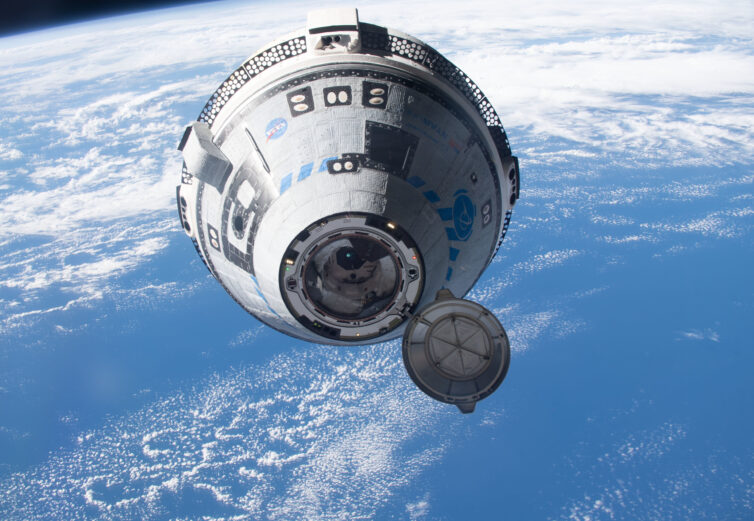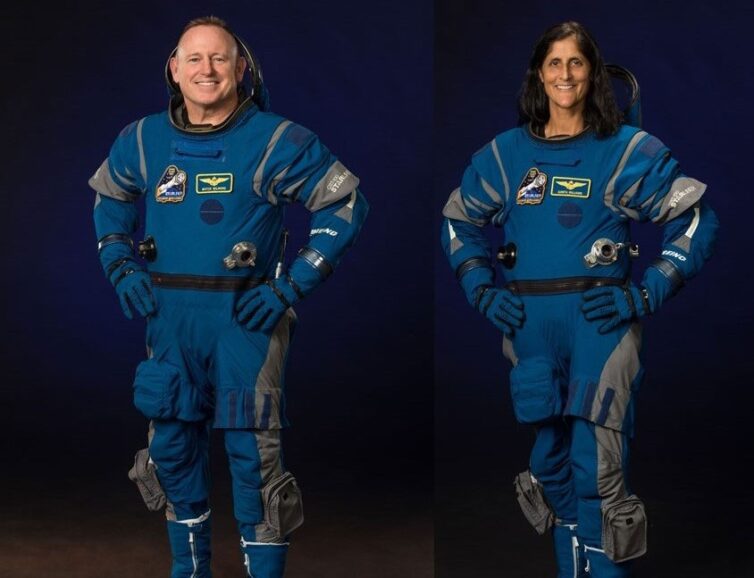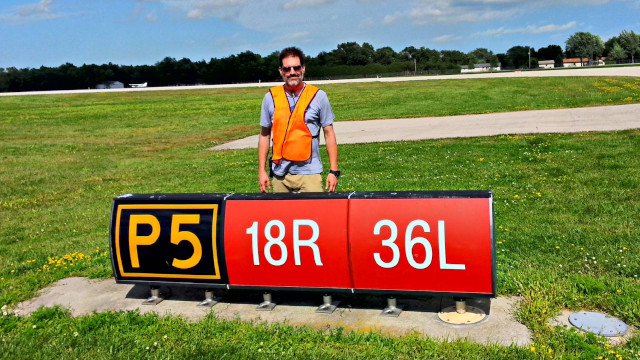
A misconception has been circulating in news and on social media for weeks that the NASA astronauts who flew the Boeing Starliner -named Calypso- to the International Space Station are “stranded in space”. It’s easy to make comparisons with airline passengers stranded mid-itinerary in unfamiliar airport terminals.
But it’s wrong.

1. Not Like Airline Passengers
This situation is not like passengers of a canceled airline flight. The astronauts aren’t stranded.
The question was which way they’re returning home. They participated in the analysis of the vehicle. We now know NASA has decided to fly the Starliner back empty. The two astronauts will return on SpaceX CrewDragon. Contrast with an airline passenger sitting helpless in an unfamiliar airport, the Starliner astronauts are highly trained and a part of the operation. It’s more like an airline pilot waiting for rescheduling at a “crash pad” in a familiar location. Or maybe like airplane manufacturer test pilots waiting with an aircraft at remote airport, maintaining the aircraft until a repair crew arrives. Since this flight is the first flight of a new spacecraft, the crew are test pilot astronauts. They have a full understanding of Starliner’s systems. The test pilots operate spacecraft systems as requested from the ground. The expectation was any problems which would come up, they’d work with engineers on the ground to solve. Except the multiple thruster malfunction was really unexpected.
2. Among NASA’s most experienced
The Starliner Crew Flight Test (CFT) astronauts are Barry “Butch” Wilmore and Sunita “Suni” Williams. They have some surprisingly similar backgrounds. Before selection as astronauts, both were US Navy test pilot instructors; Wilmore in fixed-wing jets and Williams in helicopters. Both served long-duration ISS missions of at least six months before. Both had served turns as ISS commander before being assigned to Starliner CFT. Each are currently on their third space flight.
They differ in space flights. Wilmore’s first space flight was as second-in-command pilot on STS-129 Space Shuttle Atlantis in 2009. His second launch was on a Russian Soyuz (during NASA’s gap between Space Shuttle and Commercial Crew) for a 5 1⁄2 month mission to ISS in 2014, returning in 2015.
Williams’ first and second space flights were long-duration ISS missions. On her first, she was launched on STS-116 Space Shuttle Discovery in 2006 and returned to Earth six months later on STS-117 Space Shuttle Atlantis in 2007. So she had already flown up to ISS and back on different spacecraft before. Her second launch was on a Russian Soyuz for six months in 2012. Wilmore and Williams were assigned to the Starliner CFT crew in 2020. Due to delays in Boeing’s Starliner development, they’ve been training for this mission for four years. That training included working with NASA and Boeing engineers on technical details of Starliner, developing procedures and planning training for future astronauts. Astronaut pilot training includes practicing every expected emergency scenario in simulators.
All that work can win feathers in their caps. Test pilots on first flights of new spacecraft have so far all been inducted into the Astronaut Hall of Fame after completion of their mission.
3. In flight: days, weeks, months…
After years of delays, the Starliner Crew Flight Test launched June 5, 2024. Wilmore and Williams named their spacecraft “Calypso” after Jacques Cousteau’s exploration ship. The mission was planned to dock with ISS for days and return for landing at any of several bases in the southwestern US depending on weather.
The job of any test pilot is to find how the craft differs in flight from design expectations. They help identify problems and collect data for engineers on the ground to fix. The failure of multiple thruster rockets during approach to ISS was a surprise. Testing by Boeing on the ground replicated part of the problem. But subcontractor Aerojet Rocketdyne had not seen the problem before. Further study indicates thrusters too close together may have overheated each other. In the meantime, Wilmore and Williams are not stranded with nothing to do. Remember, each of them has served months-long stays on ISS before. Each has had a turn as ISS commander. There’s a lot of work to maintain the station hardware and conduct science experiments located in many racks around the station. They know their way around to work as part of the crew on the station workload.
4. Lessons from the 2003 Columbia disaster
NASA mission managers had their turn in the spotlight. Their inaction was found by the Columbia Accident Investigation Board (CAIB) report to be a factor in the February 1, 2003 Space Shuttle Columbia accident. They missed seven opportunities to check if Columbia had been damaged when ice falling off a tank struck the left wing on launch. If they had checked, they would have needed to find ways to mitigate the problem or launch another shuttle for rescue. But they never checked. Columbia was in fact damaged by the debris strike. As grim as that lesson was, some good came from learning. With weeks of troubleshooting by engineers and the astronauts, doubts remained whether Starliner’s thrusters will be reliable enough to keep the crew safe for re-entry. The decision was to use the alternative Commercial Crew vehicle, SpaceX’s CrewDragon, to rescue the Starliner crew. This is exactly why NASA wanted two crew launch vendors.
The comparison to risks in the 2003 Columbia disaster brings back memories for me. I was an eyewitness to the smoke trail Columbia made in the pre-dawn sky over northern California. A dozen of us met near the top of Mount Hamilton near San Jose, where we all drove to get a view above the coastal fog. Some of us who had seen previous re-entries knew it should look like a red light, like a highway flare, followed by a clear meteor streak. Instead we saw a red-white light and a billowing cloud behind it. We didn’t know why. The realization of what it meant soon sank in with news Columbia didn’t arrive in Florida and was missing. As a glider, it could not have still been in flight past the landing time. It had to be down somewhere. We later learned the burning left wing broke off over Fort Worth, Texas causing in-flight breakup of the orbiter across east Texas. It was still in the peak-heating phase of re-entry. Most people saw the news after that was known.
When eyewitnesses met again later, we found out that making an effort to go see the re-entry affected us very differently than people who learned about it from the news. Though none of us knew the seven astronauts who died, we all experienced an involuntary mourning reaction as if we did. Talking with other eyewitnesses who had similar experiences was the only way to find support when no one else around us understood. None of us wants to see that again. Today with Boeing’s Starliner delays, NASA still has only one launch vendor currently operating. There’s no backup in case something grounds SpaceX. And at the time of this writing in late August 2024, SpaceX’s Falcon 9 rocket has been temporarily grounded by the FAA after a first stage booster crashed (fell over on touchdown) on a landing pad ship at sea. But that’s expected to be a relatively short grounding. SpaceX has flown hundreds of FAA-licensed space launches. Another Falcon 9 grounding in July 2024 lasted only two weeks after a second stage rocket failure that followed over 300 successful launches. SpaceX reported what caused the problem and what corrective action was planned. It was accepted by the FAA, allowing launches to resume. The loss of a Falcon 9 booster on its 23rd landing may affect the Crew-9 launch schedule. But it isn’t expected to result in a long grounding.
5. NASA decided Starliner will fly home empty
Given the history, it isn’t hard to see why NASA decided to bring Starliner back empty. The military test pilots might have chosen to accept the risk. (They can speak for themselves, but might not until after they retire from NASA.) There were enough unknown risks remaining that NASA decided for them. Wilmore and Williams will configure Starliner’s systems and software for automated uncrewed return.
The next big question is whether the thrusters will work on re-entry. The spacecraft needs to be able to point its heat shield side down before re-entry where it will protect the spacecraft from the hot plasma stream. There is redundancy in the thrusters to tolerate some failures. If enough of them fail together, the risk is that it might not have control authority to maintain the correct flight attitude on re-entry. If that happens, it would burn and break up on re-entry.
6. Astronauts to return on SpaceX CrewDragon
There is a CrewDragon already docked at ISS. But its four seats are taken by the astronauts of Crew-8. Trying to bring two more astronauts down without seats or compatible entry suits would be an option only for dire emergency. The CrewDragon for Crew-9 will launch with two crew instead of four, leaving two empty seats and suits for Wilmore and Williams. Upon Crew-9‘s arrival at ISS, they’ll be part of Crew-9 for that six-month crew rotation.
7. How bad is this for Boeing’s reputation?
It’s obviously bad. It’s probably recoverable. It doesn’t help following so soon after the Boeing 737 MAX door plug that blew out over Portland, Oregon on January 5. The renewed crisis that followed led to public ridicule, regulatory scrutiny, Congressional hearings, and ousting the CEO. Ouch.
Whether Starliner makes it back intact will determine how history records this event. If Calypso makes it back, then repairs and recovery can proceed. If not, then the investigations, reviews, and redesign may consume all the time left for Boeing to get its six crew launch contracts before ISS is retired in 2030. This isn’t the end of Boeing in space. At least not yet. Boeing is NASA’s prime contractor for ISS until 2030. They make the core stage of NASA’s SLS rocket. They built a third of the current US GPS satellites, but none of the newer ones. Without new projects, their footprint in space is shrinking. So the outcome of Starliner can influence their reputation in space up or down.
8. NASA wants commercial launch vendors to succeed
In the Space Shuttle era, NASA’s crew and cargo launch capability were grounded for years after each of the 1986 Challenger and 2003 Columbia accidents. So when the Commercial Crew and Cargo programs started, NASA wanted multiple launch vendors to take over if either are grounded. NASA expanded commercial cargo to include an upcoming third vendor Sierra Nevada after both SpaceX and Orbital Sciences (now part of Northrop Grumman) were grounded at the same time.
NASA showed SpaceX patience to re-engineer its Falcon 9 second stage after the 2014 explosion of the CRS-7 cargo launch. NASA wants two successful crew launch vendors so it has a backup when either is grounded. SpaceX gained a lot of operational experience from flying cargo to ISS before crew. Boeing is having those learning experiences on the crew vehicle at least partly because they didn’t bid for the cargo contracts. A lesson for NASA in the future is to require new crew launch vendors to do cargo first.
9. What to Watch
How will Starliner Calypso fare on automated re-entry? That’s the big question. There is confidence for SpaceX CrewDragon to return the Starliner crew safely. SpaceX’s CrewDragon fleet has flown reliably with lessons learned from the early Falcon 9 rockets and CargoDragon spacecraft. A worst case scenario would be a mishap grounding SpaceX for an extended time before Boeing is ready to be a backup at the time. The system can only tolerate one vendor grounded at a time. Currently SpaceX is picking up all the slack in NASA’s system. ISS is currently planned to be operated until 2030. As the station ages, extensions would likely be short and decreasingly likely. But NASA has pointed to a possible extension of ISS if commercial space stations aren’t ready to replace it by then. There are few remaining opportunities for Boeing to get crew launch contracts for Starliner. Its chances are best if Starliner Calypso returns intact. Boeing is initially focusing on NASA. It doesn’t yet have other customers for Starliner crew flights. In contrast, SpaceX has flown multiple civilian space flights. NASA’s intent to use fixed-price Commercial Crew and Cargo launch contracts to help build American space industry capability is working.
Don’t be too quick to believe pundits who dismiss Boeing during this difficulty. Such decisions have not been made yet at NASA. NASA wants multiple launch vendors. Boeing’s reputation depends on how they execute plans to recover both airliners and spacecraft.
Guest post, from Ian Kluft – Portland, Oregon
Ian has had enthusiasm for aviation, space and technology since grade school. Educated as a software engineer, he also got his Private Pilot license while attending university. Later upgrading to a Certified Flight Instructor added to his ability to share the interest in flight with others. For interests in space, he has traveled to see rocket launches and solar eclipses. So far the pinnacle of space interests was leading Ham Radio-licensed search teams which recovered the first amateur rocket launched to space, in Nevada in 2004. More info is at https://ikluft.github.io/ . He splits his social media accounts by topic: aviation as @ik****@av****.social on Mastodon (minimally also @ikluft on Twitter); space as @As*******@sp****.space on Mastodon (minimally also @AstroHawk on Twitter).

[ad_2]
Source link


